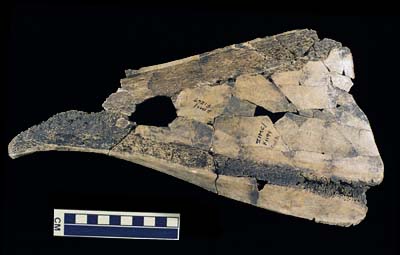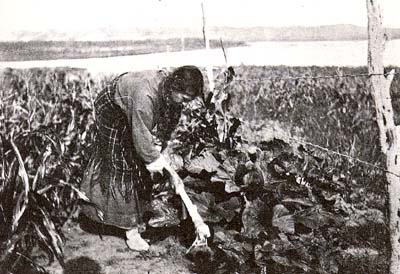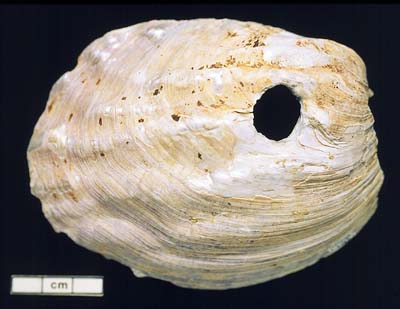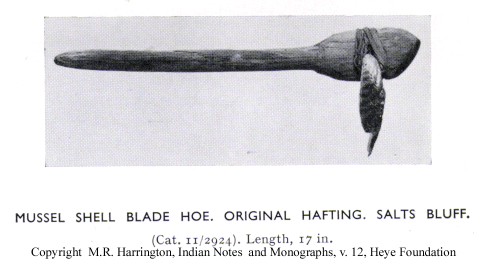Native American Tools
Bone Hoe Blade

This artifact is a hoe blade made from the scapula, or shoulder blade, of a bison (Bos bison). The maker of the artifact removed a prominent natural ridge on the outside of the scapula (acromion process) and cut a hole through the center. The broad distal end of the scapula is worn smooth from cultivating the soil.
Based on historical descriptions of these tools, the hoe blade was originally hafted to a long wooden handle. The handle would have been split at one end, grooved inside, and then attached to the narrow neck of the scapula using rawhide thongs. To prevent the blade from shifting, a stout thong would have been strung from the hole in the scapula to a groove cut in the wooden handle about a third of the way from its distal end. Scapula hoes were used to cultivate agricultural fields, but they may also have been used as general-purpose digging tools.

The specimen illustrated here is from the Zimmerman site, an historic village of the Kaskaskia Tribe of Illinois Indians. This site is located along the Illinois River near Starved Rock State Park in La Salle County. Two famous French explorers — Louis Jolliet and Father Jacques Marquette — visited this village in 1673. Marquette reported that the village contained 74 lodges, but it had swelled to 351 lodges by 1677. The Kaskaskia and other Illinois tribes raised maize (corn), beans, squash, bottle gourds, pumpkins, and watermelons.
Sources:
Brown, James A. 1961. The Zimmerman site: a report on excavations at the Grand
Village of Kaskaskia, La Salle County, Illinois. Report of Investigations
No. 9. Illinois State Museum, Springfield.
Wilson, Gilbert L. 1917. Agriculture of the Hidatsa Indians: an Indian Interpretation.
Studies in the Social Sciences No. 9. University of Minnesota, Minneapolis.
Shell Hoe Blade

This is a hoe blade made from a freshwater mussel shell. The shell is a threeridge mussel (Amblema plicata), a thick-shelled species that is common in the Illinois River. It was made by flattening the normally curved anterior edge of the shell (right side of photo) and drilling or punching a hole through the center. The working edge is the convex posterior edge of the shell (left side of photo).

A complete shell hoe found in a dry Ozark cave site in Arkansas indicates that some shell-hoe blades were lashed to carved wooden handles using bark thongs and twisted cords. The flattened anterior ends of the shells would have been inserted into notches in the handle and lashed through the central perforation.
The illustrated specimen is from the prehistoric Norris Farms 36 site, which overlooks the Illinois River floodplain in Fulton County, Illinois. This site was established by people of the Oneota culture during the thirteenth century (A.D. 1230-1280) (Santure et al. 1990).
Sources:
Harrington, M. R. 1960. The Ozark Bluff-Dwellers. Indian Notes and Monographs
Vol. 12. Museum of the American Indian, Heye Foundation, New York.
Santure, Sharron K., Alan D. Harn, and Duane Esarey. 1990. Archaeological
Investigations at the Morton Village and Norris Farms 36 Cemetery. Reports
of Investigations No. 45. Illinois State Museum, Springfield.
Stone Hoe Blade
This is a chipped-stone hoe blade made of Mill Creek chert. Mill Creek is a tough, coarse-grained chert—brown or gray in color—that is found only in southern Illinois (Union and Alexander counties). It occurs in nature as large, flat, elliptical nodules in creek beds or in hill-top residuum. The chert nodules probably derive from the Ullin limestone formation of the Mississippian geologic system. Mill Creek chert was prized by Mississippian Indians as a raw material for manufacturing stone hoes, probably because of its toughness and resistance to breakage. Chert nodules were intensively quarried in the Mill Creek area and processed to manufacture bifaces in nearby villages. The bifaces were important trade items that were distributed widely in the central Mississippi and Ohio river valleys from A.D. 900-1400.
Stone hoes probably were hafted to wooden handles using rawhide or bark thongs. The working edges of the blades would become dull after extended use and were periodically resharpened. Broken hoes and resharpening flakes litter the ground in the American Bottom region of southwestern Illinois. Many hoes and hoe-resharpening flakes have lustrous silica gloss on their outer surfaces, confirming the use of hoes as digging or cultivation tools.
Three different types of stone hoe blades have been documented in Mississippian archaeological sites: oval, flare-bitted, and notched. The three types may have been used in different ways (digging versus hoeing, for example) or they may have been popular at different times in prehistory. Research is needed to understand why there are three different types. The specimen illustrated here is a flare-bitted type from the American Bottom region of southwestern Illinois (Madison County).
Illustrations:
Flare-bitted stone hoe blade made of Mill Creek chert from Madison County,
Illinois (ISM-824193; length = 21.8 cm).
Mississippian woman hoeing her garden with a stone-bladed hoe (Peoples of
the Past exhibit, Illinois State Museum).
Sources:
Butler, Brian M., and Charles R. Cobb. 2001. The Dillow’s Ridge Site
and the Production of Mill Creek Chert Tools. Illinois Archaeology 13: 57-87.
Cobb, Charles R. 1989. An Appraisal of the Role of Mill Creek Chert Hoes in
Mississippian Exchange Systems. Southeastern Archaeology 8: 79-92.
Cobb, Charles R. 2000. From Quarry to Cornfield: the Political Economy of
Mississippian Hoe Production. University of Alabama Press, Tuscaloosa.
Robert E. Warren
NativeAmericanHoes.wpd
December 15, 2003







